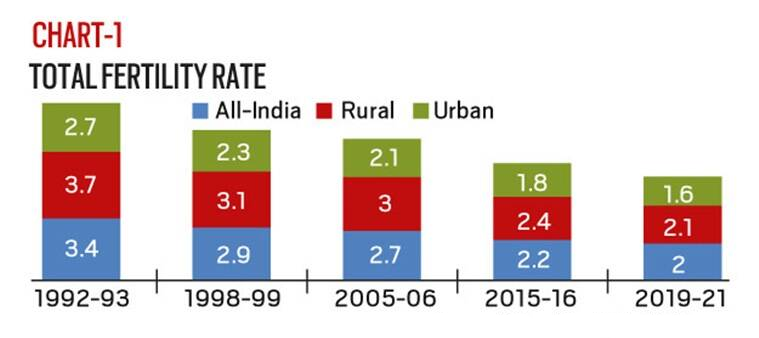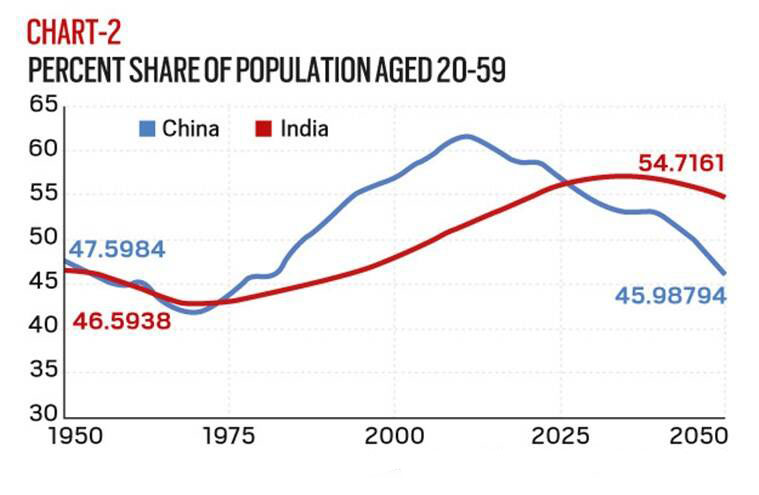Indian Society
Trends in Demography
- 23 Nov 2022
- 7 min read
For Prelims: India’s demographic dividend, TFR, Maternal mortality ratio
For Mains: Demographic Changes of India, Significance of Population Growth
Why in News?
According to the projection by the United Nations, in 2022, China will for the first time register an absolute decline in its population and in 2023, India’s population to reach 1,428.63 million, will surpass China’s 1,425.67 million.
What are the Drivers of Population Change?
- Total Fertility Rate (TFR):
- TFR has fallen for India in the last three decades.
- Between 1992-93 and 2019-21, it came down from 3.4 to 2; the fall was especially significant in the rural areas.
- In 1992-93, the average rural Indian woman produced one extra child compared to her urban counterpart (3.7 versus 2.7). By 2019-21, that gap had halved (2.1 versus 1.6).
- A TFR of 2.1 is considered as “replacement-level fertility”.
- The TFR is the average number of births by women aged 15-49 based on surveys for a particular period/year.
- TFR has fallen for India in the last three decades.
- Fall in Mortality:
- Crude Death Rate (CDR) fell to single digits for China first in 1974 (to 9.5) and for India in 1994 (9.8), and further to 7.3-7.4 for both in 2020.
- The CDR was 23.2 for China and 22.2 for India in 1950.
- CDR is the number of persons dying per year per 1,000 population.
- Mortality falls with increased education levels, public health and vaccination programmes, access to food and medical care, and provision of safe drinking water and sanitation facilities.
- Crude Death Rate (CDR) fell to single digits for China first in 1974 (to 9.5) and for India in 1994 (9.8), and further to 7.3-7.4 for both in 2020.
- Life Expectancy at Birth:
- Between 1950 and 2020, life expectancy at birth went up from 43.7 to 78.1 years for China and from 41.7 to 70.1 years for India.
- Reduction in mortality normally leads to a rising population. A drop in fertility, on the other hand, slows down population growth, ultimately resulting in absolute declines.
- Between 1950 and 2020, life expectancy at birth went up from 43.7 to 78.1 years for China and from 41.7 to 70.1 years for India.
What are the Implications of the Trends for China?
- China’s TFR was 1.3 births per woman, marginally up from the 1.2 in the 2010 and 2000 censuses, but way below the replacement rate of 2.1.
- From 2016, China officially ended its one-child policy which was introduced in 1980.
- The UN, nevertheless, projects its total population at 1.31 billion in 2050, a 113 million-plus drop from the 2021 peak.
- The decline in China's population of prime working age is concerning as it creates a vicious cycle wherein the number of working people to support dependent decreases but the number of dependents starts increasing.
- The proportion of the population aged between 20 and 59 years crossed 50% in 1987 and peaked at 61.5% in 2011.
- As the cycle reverses, China's working-age population will fall below 50% by 2045.
- Moreover, the average (median) age of the population, which was 28.9 years in 2000 and 37.4 years in 2020, is expected to soar to 50.7 years by 2050.
What are the Steps taken by India to Control Population?
- India became one of the first developing countries to come up with a state-sponsored family planning programme in the 1950s.
- A population policy committee was established in 1952.
- In 1956, a Central Family Planning Board was set up and its focus was on sterilisation.
- In 1976, GOI announced the first National Population Policy.
- National Population Policy, 2000 envisaged achieving a stable population for India.
- The Policy aims to achieve stable population by 2045.
- One of its immediate objectives is to address the unmet needs for contraception, health care infrastructure, and personnel and provide integrated service delivery for basic reproductive and child health care.
- National Family Health Survey (NFHS) is a large-scale, multi-round survey conducted in a representative sample of households throughout India.
- NFHS has had two specific goals:
- To provide essential data on health and family welfare needed for policy and programme purposes.
- To provide information on important emerging health and family welfare issues.
- NFHS has had two specific goals:
- Realising the potential of education in tackling the problems of growing rate of population, the Ministry of Education launched a Population Education Programme with effect from 1980.
- The Population Education programme is a central sector scheme designed to introduce Population Education in the formal education system.
- It has been developed in collaboration with the United Nations Funds for Population Activities (UNFPA) and with the active involvement of the Ministry of Health and Family Welfare.
Way Forward
- There is an opportunity for India to reap a demographic dividend as its working-age population's share of the overall population reached 50% only in 2007 and will peak at 57% by the mid-2030s.
- But reaping demographic dividend is contingent upon the creation of meaningful employment opportunities for a young population.
- There needs to be preparedness with suitable infrastructure, conducive social welfare schemes and massive investment in quality education and health.
- For those already in the 25-64 age bracket, there is a need for skilling, which is the only way to ensure they are more productive and have better incomes.
- New skills and opportunities for women and girls befitting their participation in a 3 trillion dollar economy is urgently needed.
UPSC Civil Services Examination, Previous Year Question (PYQ)
Prelims
Q. As per India’s National Population Policy, 2000, by which one of the following years is it our long-term objective to achieve population stabilization? (2008)
(a) 2025
(b) 2035
(c) 2045
(d) 2055
Ans: (c)
Mains
Q. Discuss the main objectives of Population Education and point out the measures to achieve them in India in detail. (2021)








